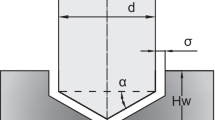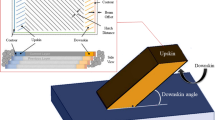Abstract
Ring rolling is an established method to produce seamless rings of different cross-sectional geometries. For dish shaped rings, there are applications in different areas such as offshore, aeronautics or the energy sector. At the moment, dish shaped rings are produced by machining of rings with rectangular shaped cross section, by (open die) hollow forging on a conical mandrel or by using shaped ring rolling tools. These ways of manufacturing have the disadvantage of high material waste, additional costs for special tools, long process time and limited or inflexible geometries. Therefore, the manufacturing of dish shaped rings on conventional radial-axial ring rolling mills would expand the range of products for ring producers. The aim of this study is to investigate the feasibility of an alternative to the current manufacturing processes, without requiring additional tooling and material costs. Therefore, the intended formation of dish shaped rings—previously regarded as a form error—is investigated. Based on an analysis of geometrical requirements and metal flow mechanisms, a rolling strategy is presented, causing dishing and ring climbing by a large height reduction of the ring. Using this rolling strategy dish shaped rings with dishing angles up to 18° were achieved. In addition to the experiments finite element method (FEM)—simulations of the process have been successfully conducted, in order to analyze the local strain evolution. However, when the contact between ring and main roll is lost in the process the ring starts to oscillate around the mandrel and neither dishing nor ring climbing is observed.











Similar content being viewed by others
References
Keeton CR (1988) Ring rolling. In: Metals handbook: forming and forging. ASM International, pp 224–268
Koppers U, Michl D (2012) Ringwalzen. In: Hoffmann H, Neugebauer R, Spur G (eds) Handbuch Umformen. Carl Hanser, München, pp 187–195
Jenkouk V, Seitz J, Hirt G (2013) Ring rolling of non-rectangular cross-sections. RWTH-Aachen, pp 55–64
Marczinski H-J (1974) The actual state of development of up-to-date ring rolling mills. Stahl Eisen 94(24):1207–1211
Koppers U, Wiegels H, Dreinhoff P, Henkel J, Kopp R (1986) Methoden zur Verringerung des Material- und Energieeinsatzes beim Ringwalzen. Stahl Eisen 106(14/15):785–789
Lieb A (1991) Minimierung von Formfehlern beim Ringwalzen. Dissertation, Institut für Bildsame Formgebung, RWTH-Aachen
Goldbach VA (2011) Konzepte zur Erweiterung des walzbaren Geometriespektrums. Dissertation, Institut für Bildsame Formgebung, RWTH-Aachen
Jenkouk V, Hirt G, Franzke M, Zhang T (2012) Finite element analysis of the ring rolling process with integrated closed-loop control. CIRP Ann Manuf Technol 61(1):267–270
Acknowledgments
The authors would like to thank the ″Deutsche Forschungsgemeinschaft” (DFG) for the financial support of these works within the project HI 79035-1 “Methode zur Herstellung nahtloser konischer Ringe mit definiert eingestellten Neigungswinkeln auf Radial-Axial Ringwalzwerken”.
Author information
Authors and Affiliations
Corresponding author
Rights and permissions
About this article
Cite this article
Seitz, J., Jenkouk, V. & Hirt, G. Manufacturing dish shaped rings on radial-axial ring rolling mills. Prod. Eng. Res. Devel. 7, 611–618 (2013). https://doi.org/10.1007/s11740-013-0486-y
Received:
Accepted:
Published:
Issue Date:
DOI: https://doi.org/10.1007/s11740-013-0486-y




